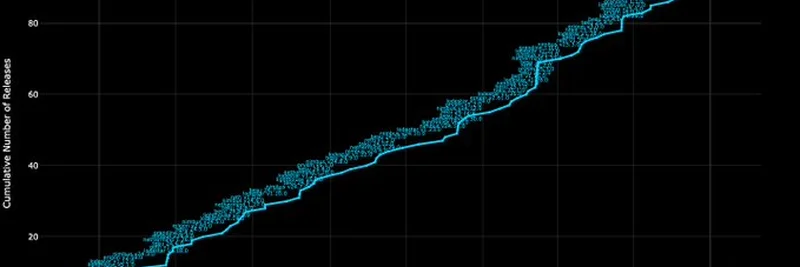Hey there, crypto enthusiasts! If you’ve been keeping an eye on the blockchain world, you’ve probably noticed the recent buzz on X about Ethereum and Solana’s development pace. A tweet from Sam Calder-Mason (@samcmAU) on July 10, 2025, has sparked a lively conversation, and we’re diving into it today on meme-insider.com. Let’s break down this Ethereum vs Solana Agave release timeline showdown and see what it means for the future of blockchain technology!
The Tweet That Started It All
Sam’s post features a striking chart comparing the cumulative number of releases for Ethereum and Solana’s Agave client over the past 15 months. The image tells a fascinating story:
- Ethereum (in blue) shows an impressive 94 client updates, with a steep upward curve that reflects constant activity from teams like go_ethereum, NethermindEth, and HyperledgerBesu.
- Solana’s Agave (in orange) logs just 6 updates, with milestones like Agave v1.7, v1.8, v2.0, v2.1, v2.2, and v2.3, credited to anza_xyz.
Sam’s caption? “94 ethereum client updates in 15 months. outstanding work @go_ethereum @NethermindEth @HyperledgerBesu @ErigonEth @paradigm @prylabs @sigp_io @Teku_Consensys @ethnimbus @lodestar_eth @grandineio for making shipping look effortless.” This was a cheeky response to an earlier tweet by Brian (@0xbrw) praising Solana’s 6 updates, which kicked off this friendly rivalry.
What’s Behind the Numbers?
So, what do these numbers mean? Let’s simplify it. In blockchain, “client updates” are like software patches that keep the network running smoothly. Ethereum’s high update count shows a decentralized effort from multiple development teams, each working on different clients (e.g., Geth, Nethermind) to enhance security, speed, and features. Solana, on the other hand, relies on a more centralized approach with Anza leading the Agave updates, which might explain the lower number but doesn’t necessarily reflect quality.
The chart highlights Ethereum’s relentless pace, especially since early 2024, while Solana’s updates are more spaced out, with significant jumps at major version releases. This difference ties into how each blockchain handles scalability and decentralization—Ethereum’s diversity versus Solana’s streamlined design.
The Community’s Reaction
The X thread exploded with reactions! Some users, like @nixorokish, cheered the Ethereum team’s efforts with a “hahaha we had the same thought!” Others, like @philngo_, threw in a dramatic “Somebody call 9-1-1” meme, while @sbetamc showed “RESPECT” with a classic GIF. It’s clear this comparison has struck a chord, blending humor with pride in blockchain innovation.
But not everyone was on board. @sassal0x from the earlier thread called out the comparison as “disingenuous,” arguing that minor client releases shouldn’t be pitted against network upgrades. This debate adds depth—are we measuring apples and oranges here?
Why It Matters for Meme Tokens and Blockchain Practitioners
At meme-insider.com, we’re all about keeping you in the loop on how these developments impact meme tokens and the broader crypto space. Ethereum’s frequent updates could mean faster integration of new features for decentralized apps (dApps) and meme token projects, boosting innovation. Solana’s steady releases, meanwhile, support its reputation for high-speed transactions, a big draw for meme coin traders.
For blockchain practitioners, this showdown is a goldmine. It’s a chance to study how different development strategies affect network reliability and growth. Whether you’re building on Ethereum or Solana, understanding these timelines can help you plan upgrades and stay competitive.
Final Thoughts
The Ethereum vs Solana Agave release timeline debate is more than just a numbers game—it’s a window into the soul of blockchain development. Ethereum’s 94 updates in 15 months showcase a collaborative, fast-moving ecosystem, while Solana’s 6 strategic releases highlight a focused approach. Which is better? That depends on your priorities—diversity or efficiency.
What do you think? Drop your thoughts in the comments, and stay tuned to meme-insider.com for more updates on meme tokens and blockchain tech. Let’s keep the conversation going!


